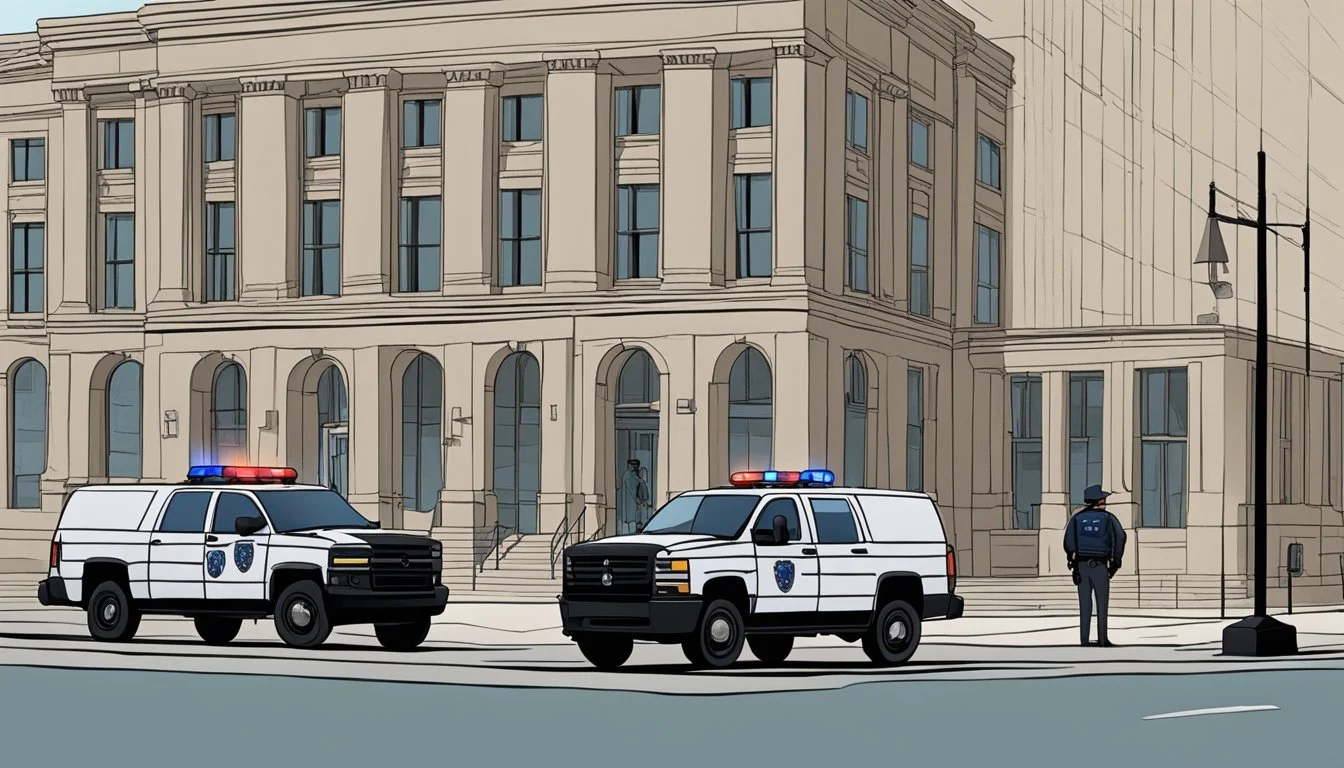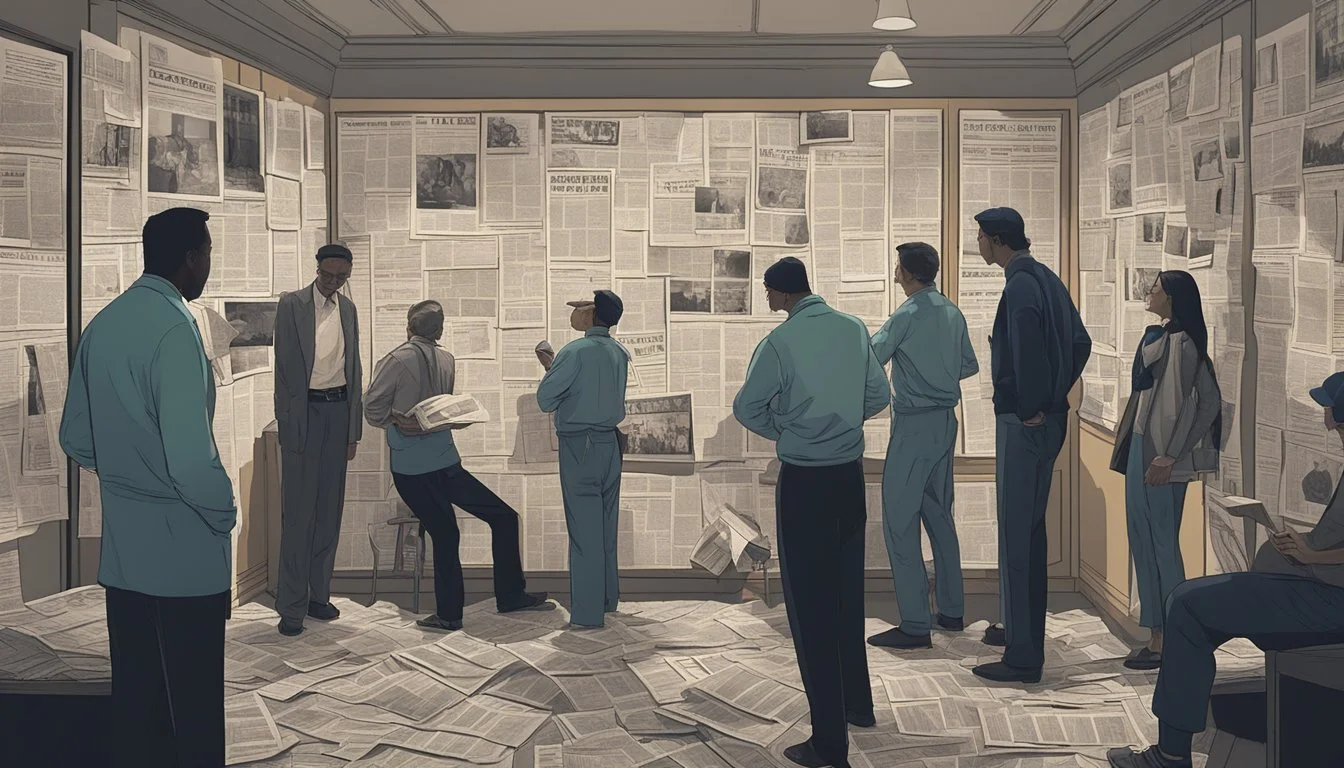Maury Travis' Riverman Requiem: St. Louis Strangler's Suicide Ends Serial Killer's Reign of Terror
Maury Travis, known as the St. Louis Strangler, terrorized the city's streets in the early 2000s. This serial killer targeted vulnerable women, primarily sex workers, leaving a trail of violence and fear in his wake. Travis was linked to the murders of at least 12 women, though he claimed to have killed 17 in a chilling letter to authorities.
The case took a dramatic turn when police used a map sent by Travis to trace his location. This virtual trail led investigators to his home in Ferguson, Missouri. Travis's crimes were particularly disturbing due to his habit of videotaping his victims, earning him the additional moniker "The Videotape Killer."
The saga of the St. Louis Strangler came to an abrupt end on June 10, 2002, when Travis took his own life in jail. His suicide left many questions unanswered and denied closure to the families of his victims. The Travis case remains a haunting chapter in St. Louis true crime history, showcasing the dark underbelly of a city and the devastating impact of one man's actions.
Biographical Background of Maury Travis
Maury Troy Travis was born on October 25, 1965. He grew up in Ferguson, a suburb of St. Louis, Missouri. As a young adult, Travis worked as a hotel waiter in the St. Louis area.
In 1989, Travis was convicted of armed robbery. This conviction resulted in a prison sentence, after which he was released on parole.
Despite his seemingly ordinary job, Travis harbored dark impulses. He began targeting vulnerable women in the St. Louis area, primarily those involved in sex work or struggling with addiction.
Travis lived in a house in Ferguson that would later become infamous. This property served as the site for many of his crimes.
By the early 2000s, Travis had escalated to serial murder. He claimed in a letter to have killed 17 women, though the exact number remains uncertain. Some authorities believed the count could be as high as 20 victims.
Travis recorded his crimes on videotape, earning him the moniker "The Videotape Killer." He was also known as "The Street Walker Strangler" due to his choice of victims.
His criminal activities came to an end in June 2002 when the FBI identified him as a suspect. Faced with imminent arrest, Travis died by suicide on June 10, 2002, at the age of 36.
Timeline of Crimes
Maury Travis's criminal activities spanned several years, escalating from early warning signs to a brutal spree of murders targeting vulnerable women in St. Louis. His crimes left a trail of devastation and terror in the community.
Early Indicators of Criminal Behavior
Travis's criminal tendencies emerged well before his murder spree. In 1989, he was convicted of armed robbery, serving time in prison. This conviction hinted at his propensity for violence and disregard for the law. Upon release, Travis struggled with drug abuse, further fueling his dangerous impulses.
His behavior grew increasingly erratic and threatening. Acquaintances reported Travis exhibiting hostile attitudes towards women. He frequented areas known for prostitution, displaying a troubling fascination with vulnerable individuals on the fringes of society.
Reign of Terror
Travis's murderous rampage began in the late 1990s. He primarily targeted sex workers and drug-addicted women in St. Louis. His modus operandi involved:
Luring victims into his vehicle
Transporting them to remote locations
Subjecting them to torture and sexual assault
Strangling victims to death
Disposing of bodies in abandoned buildings or wooded areas
Travis videotaped his crimes, earning him the moniker "Videotape Killer." He claimed to have murdered 17 women, though some estimates suggested up to 20 victims. The FBI linked him definitively to at least 12 murders.
His reign of terror lasted until 2002 when a map he sent to a newspaper led to his identification and arrest. Travis took his own life in jail before facing trial, leaving many questions unanswered about the full extent of his crimes.
Victims and Case Profiles
Maury Travis targeted vulnerable women, primarily sex workers, in the St. Louis area. His crimes followed a distinct pattern, leaving behind crucial evidence at various crime scenes.
Victimology
Travis preyed on sex workers, often African American women. He exploited their vulnerability and high-risk lifestyles. Many victims were last seen in areas known for prostitution.
The exact number of Travis's victims remains uncertain. Police linked him to at least 12 murders, though Travis claimed to have killed 17 women in a letter to the media.
Some identified victims included Mary Shields and Alysa Greenwade. Their deaths helped authorities establish connections between multiple cases.
Crime Scenes Examination
Travis typically strangled his victims, earning him the moniker "Street Walker Strangler." He often left bodies in abandoned buildings or remote areas.
Crime scenes revealed Travis's meticulous nature. He sometimes bound victims with duct tape or zip ties. Investigators found DNA evidence at several locations.
A key piece of evidence was a videotape Travis sent to a newspaper. It showed him torturing a victim in his basement, providing crucial leads for law enforcement.
Travis's home, later discovered to be a torture chamber, contained bloodstains and other forensic evidence linking him to multiple murders.
Investigation Methodology
The investigation into Maury Travis' crimes involved sophisticated techniques and faced significant obstacles. Law enforcement utilized both traditional and cutting-edge methods to track the elusive killer.
Law Enforcement Techniques
Police employed surveillance, forensic analysis, and profiling to build their case. Detectives meticulously examined crime scenes for DNA evidence and other physical clues. They also utilized geographic profiling to identify potential areas where Travis might strike next.
Task forces were formed to coordinate efforts across multiple jurisdictions. Investigators conducted extensive interviews with witnesses and potential victims who had escaped. Undercover officers were deployed in high-risk areas to gather intelligence and protect vulnerable individuals.
Breakthroughs and Challenges
The major breakthrough came when Travis mailed a map to a newspaper, leading police to a victim's body. FBI analysts traced the map to a website, which ultimately revealed Travis' identity.
Challenges included a lack of physical evidence at some scenes and difficulty identifying victims due to their marginalized status. The transient nature of many victims complicated efforts to establish timelines and connections between cases.
Investigators also struggled with limited resources and public apathy towards crimes against sex workers. Travis' suicide shortly after his arrest left many questions unanswered about the full extent of his crimes.
Arrest and Legal Proceedings
Maury Travis's reign of terror came to an end through a combination of technological tracking and swift law enforcement action. His capture led to charges for multiple murders, though the full extent of his crimes remained unclear.
Capture and Arrest
In June 2002, law enforcement agencies tracked Maury Travis using internet records. He had sent a map to a local newspaper, which investigators traced to his computer. The FBI and local police surrounded Travis's Ferguson, Missouri home. They apprehended him without incident.
During the arrest, authorities found incriminating evidence in Travis's residence. This included videotapes of his crimes and items belonging to victims. The discovery shocked investigators and provided crucial proof of his involvement in multiple murders.
Questioning and Charges
After his arrest, Travis faced intense questioning from law enforcement. He initially denied involvement but later made partial admissions. Prosecutors charged him with two counts of kidnapping resulting in death, a federal offense.
The charges related to the murders of Alysa Greenwade and Betty James. Both women had been strangled. Investigators believed Travis was responsible for up to 20 killings, mainly targeting sex workers in the St. Louis area.
Travis never faced trial. On June 10, 2002, he hanged himself in his St. Louis County jail cell. His suicide left many questions unanswered about the full scope of his crimes.
The Intersection of True Crime and Popular Culture
True crime narratives captivate audiences through various media formats, blurring the lines between reality and entertainment. This phenomenon extends to fictional portrayals, influencing public perceptions of criminal cases.
Media Representation
True crime documentaries and podcasts have surged in popularity, offering in-depth explorations of real-life criminal cases. These productions often blend factual reporting with dramatic storytelling techniques, creating compelling narratives for audiences. Television networks and streaming platforms have capitalized on this trend, producing series that reconstruct infamous crimes and investigations.
The Maury Travis case gained renewed attention through such media coverage. A woman in St. Louis discovered she was living in Travis's former residence after watching a true crime show featuring the property. This incident highlights the pervasive nature of true crime content and its unexpected real-world impacts.
Public Perception and the 'Office' Connection
Popular culture frequently incorporates true crime elements into fictional narratives, shaping public perceptions of criminal behavior. The television show "The Office" exemplifies this trend with its recurring "Scranton Strangler" storyline.
In the series, the character Toby Flenderson (played by Paul Lieberstein) becomes obsessed with the case of George Howard Skub, the alleged Scranton Strangler. This subplot serves as both comic relief and a commentary on society's fascination with serial killers.
The fictional Dunder Mifflin paper company becomes a backdrop for discussions about the Scranton Strangler, mirroring real-world water cooler conversations about high-profile criminal cases. This integration of true crime themes into mainstream entertainment reflects the genre's growing influence on popular culture.
Travis' Confinement and Suicide
Maury Travis was arrested in June 2002 after an FBI investigation linked him to several murders in the St. Louis area. He was held in federal custody pending charges for at least two homicides.
Travis never faced trial or potential execution. On June 10, 2002, just days after his arrest, he was found dead in his cell at the St. Louis County Jail.
The 36-year-old waiter had fashioned a noose from a braided bedsheet and hanged himself. His suicide cut short any judicial proceedings that may have led to a death penalty case.
Travis left behind a chilling legacy. Though officially tied to two murders, he claimed in a letter to have killed 17 women. Some investigators believed the true number could be as high as 20.
His death meant that many questions surrounding his crimes remained unanswered. Families of his suspected victims were denied closure through the legal system.
Travis' suicide also precluded any possibility of appeals or Supreme Court intervention, as sometimes occurs in capital cases. His guilt was never formally established in court.
Ethical Discussion on Serial Crime Reporting
Reporting on serial killers and their crimes raises complex ethical questions. Media coverage can impact victims' families and potentially influence ongoing investigations. Balancing public interest with sensitivity and responsible journalism is crucial.
Impact on Victims' Families
Serial killer reports often reopen wounds for victims' families. Media attention can cause distress and trauma, especially when graphic details are shared. Some families may feel their privacy is invaded or that their loved ones are reduced to statistics.
News outlets must weigh the public's right to information against protecting families' dignity. Thoughtful reporting focuses on victims' lives rather than sensationalizing their deaths. Journalists can provide support resources and give families a voice if they wish to speak.
Ethical reporting avoids glorifying the killer or providing a platform for notoriety. Instead, it examines systemic issues that allowed the crimes to occur.
Responsibility of Media
Media organizations have a duty to inform the public about serious crimes while adhering to ethical standards. Responsible reporting on serial killers requires careful fact-checking and collaboration with law enforcement.
Journalists must avoid interfering with active investigations. Withholding certain details may be necessary to protect case integrity. Media should also be cautious about inspiring copycat crimes through excessive coverage.
Ethical reporting examines the broader context of serial killings, including societal factors and vulnerabilities of targeted groups. It can raise awareness about victim support and crime prevention.
Balanced coverage educates the public without exploiting tragedy for ratings. Media should prioritize accuracy, empathy, and public service over sensationalism when covering serial crime cases.
Psychological Analysis of Maury Travis
Maury Travis exhibited traits consistent with antisocial personality disorder and psychopathy. His predatory behavior targeted vulnerable individuals, suggesting a lack of empathy and disregard for human life.
Travis's history of armed robbery and drug abuse indicates a pattern of criminal behavior and impulsivity. These factors likely contributed to his escalation into serial murder.
The killer's decision to contact law enforcement and media outlets demonstrates a desire for recognition and notoriety. This narcissistic tendency is common among serial offenders seeking to assert power and control.
Travis's meticulous documentation of his crimes through video recordings reveals a compulsive need to relive his experiences. This behavior aligns with the organized offender typology in criminal profiling.
The apparent disconnect between Travis's public persona as a hotel waiter and his private life as a serial killer suggests compartmentalization. This psychological mechanism allowed him to maintain a façade of normalcy while engaging in heinous acts.
Travis's ultimate decision to take his own life may indicate an inability to face the consequences of his actions. It could also represent a final act of control when confronted with imminent capture and exposure.
Conclusion
Maury Travis left a dark legacy as the St. Louis Strangler. His crimes shocked the community and devastated victims' families. Travis' suicide in custody prevented a trial but brought an end to his reign of terror.
The case highlighted vulnerabilities of sex workers and substance users. It also demonstrated the power of digital forensics in tracking killers. Travis' capture showed how even tech-savvy criminals can leave virtual breadcrumbs.
Questions remain about Travis' true victim count. He claimed 17 murders, but was only conclusively linked to a handful. The full extent of his crimes may never be known.
Travis' story serves as a sobering reminder of the dangers that can lurk in society's shadows. It underscores the importance of protecting vulnerable populations and leveraging technology to solve complex cases.
The St. Louis Strangler case continues to be studied by law enforcement and true crime enthusiasts. It offers valuable lessons in criminal psychology, investigative techniques, and the evolution of serial killer investigations in the digital age.










